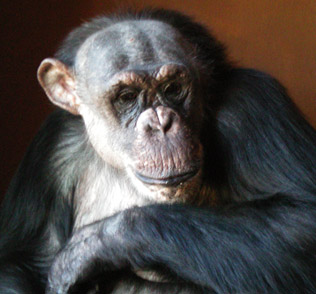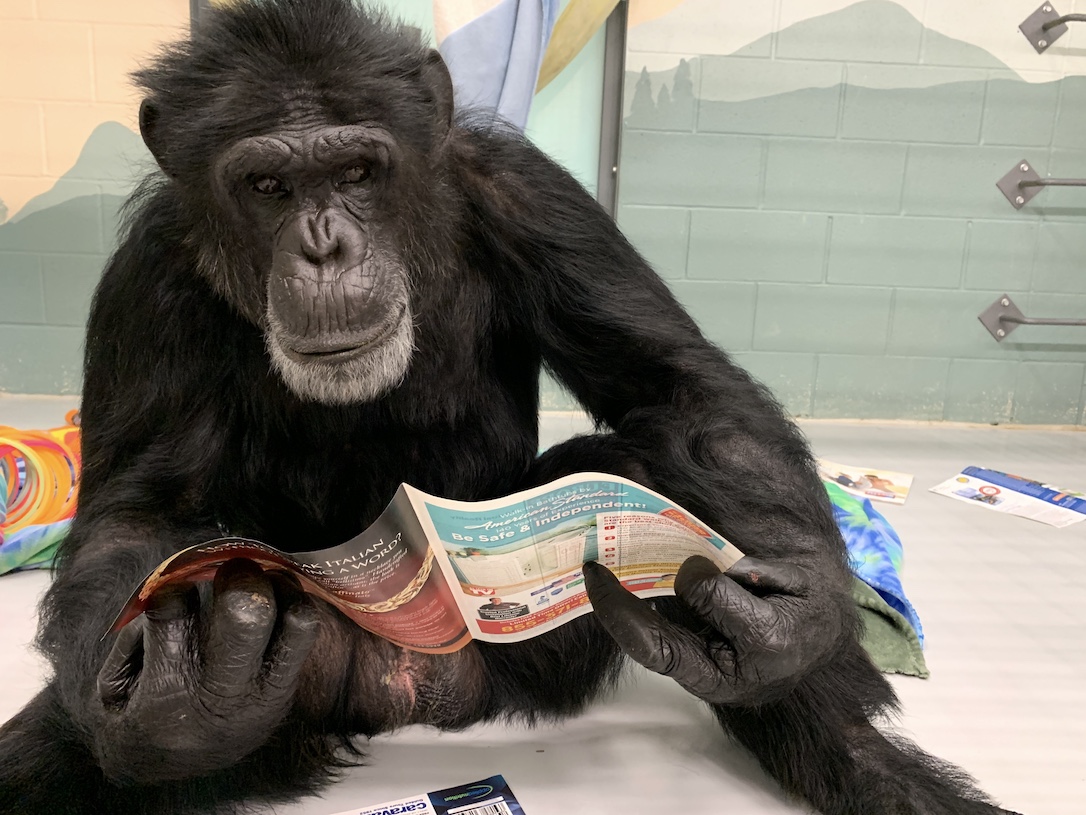Negra is a grumpy old lady. I have a feeling she’s been a grumpy old lady since she was born.
Mind you, we didn’t even know Negra until she was 35 years old. We met during our first trip to the Buckshire Corporation in Pennsylvania, back in 2007. Technically we didn’t even really meet her that time, because she hid behind the solid panel of her cage during most of the visit. My only memory of her from that initial encounter was the sight of her fingers reaching through the food slot, signalling that it was time for more peanuts.
During subsequent trips she started to come out of her shell, but only slightly. She was aloof, overweight, and severely arthritic. Her skin was ashen. In contrast to the others, who studied us intently, spat upon us, and even invited us to play, Negra remained largely disengaged. She seemed to have given up long ago.
Near the end of our final visit, we emerged from the stuffy, windowless basement in which they were kept and removed our PPE. We sat on a nearby picnic table to cool off and began talking about what we thought life might have in store for Negra and her six companions once they made their cross-country journey to Chimpanzee Sanctuary Northwest. Everyone agreed: Negra was in such a state that if we could just give her one year in sanctuary, we would consider it a victory. It felt like a big if.
For Negra, everything about her life in sanctuary was new. As far as we know, she hadn’t seen the sun or breathed fresh air in decades. As an infant, she had been captured in Africa and shipped to the United States for use as a biomedical research subject. She spent much of her life at the infamous Coulston Foundation in New Mexico, where she was bred to produce more chimpanzees for research and where she underwent regular dartings, biopsies, and surgeries as the subject of hepatitis vaccines safety trials. She had given birth to three children, all taken from her prematurely (and all, thankfully, later released from research as well – Angel and Noah now live at Save the Chimps in Florida and Heidi lives at Chimp Haven in Louisiana). When we met Negra at Buckshire in 2008, she was in a tortuous state of limbo: no longer leased to other laboratories for active research but needlessly confined to a barren cage nonetheless.
The sanctuary in 2008 was still a work in progress. But despite the outdoor area being still unfinished, Negra’s new home gave her room to walk and climb as well as sunshine and nearly endless vistas from every window of her two-story playroom. Somehow, seeing her in the environment of the sanctuary made her sickly state that much more apparent. At the lab, it was to be expected. At the sanctuary, and in the light of day, it was a shocking contrast.
We learned early on that Negra does things in her own time. And by that I mean some other time. Her bed—one of the many simple comforts she was never afforded—became a protective cocoon, the one place where she finally felt safe. We counted ourselves lucky on the rare occasions when she emerged from it to grace us with her presence.
Time passed surprisingly quickly in those early days. As the first anniversary of the chimps’ arrival rolled around, we toasted the fact that Negra had achieved her year in sanctuary. She had done it! And yet, rather than feeling like a the happy ending we envisioned, it started to feel more like a new beginning.
Two years later, we were able to complete the larger outdoor habitat where Negra, at the age of 38, finally stepped all the way outdoors.
It was a big deal to us. Her reaction, on the other hand, was a resounding big whoop…Bed was much warmer and softer, anyway, and far less chimpy and peopley.
But over time she would come to enjoy the outdoors as she does everything else: In her own way and on her own time. She only took advantage of the lower quarter of the 2-acre enclosure, perhaps fearing the thought of being so far away from the comfort and security of the familiar. Still, it was always exciting to catch her outside. Calls could be heard over the staff’s two-way radios whenever she emerged: Negra is outside! Negra is outside! Upon hearing the news, everyone would leave their tasks momentarily to watch her bask, however briefly, in the morning sun.
Negra has now had far more than the single year we had hoped to provide to her in sanctuary. In fact, she has now lived for over 15 years outside that hellish basement. And somehow she actually becomes younger with each passing year.
Last spring, as I was walking to the chimp house, I saw a lone figure moving through the tall grass at the very top of the hill, as far away from the building as you can get. I grabbed a camera with a telephoto lens and raced to catch up, partly to document the occasion but mostly because I couldn’t believe my naked eyes. When I reached the top I saw Negra atop the climbing tower, looking out across the Cascade Mountains and nibbling gently on a pine bough. At the age of 49, she was still recovering, still making progress, just as she does everything else: in her own time.
Of course, neither time nor experience in sanctuary have softened the old lady. Negra, now 50, is still a grump. And she’d still prefer the comfort of a warm nest to an outdoor adventure any day.
But who are we to tell a chimpanzee how to live? I’ll always find joy in witnessing those moments of courage but I recognize that sanctuary means different things to different people. For Negra it means peanuts and lettuce, sweet spring grass, a troll doll companion in the summer, peanut butter food puzzles, wrestling with her friend Burrito, a heaping pile of blankets, an occasional walk through the grass, and, perhaps most importantly, the freedom to choose among them as she pleases.
It’s a life made possible by those who have supported this sanctuary, with a special thanks to Negra’s Pals, Vicki, Monica, Chris & Lee Ann, Donna, Kathleen, Sharlene, Star, Stacey, Lorna, Jean, Melissa & Bruce, Jenny, and Alice.
You can be Negra’s Pal, too, and give this grumpy old lady the Valentine she deserves.




















